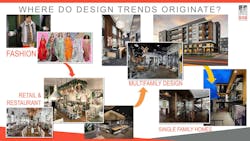From Fashion to Facade: How Homes are Getting Bolder and Edgier
Where do trends originate from? What determines the longevity of a trend? Influences in design can come from unlikely places, and even end up altering trends in other industries.
Jeff Mulcrone, principal and director of design, BSB Design, argues that recent national trends in the single- and multifamily market gained influence from an unlikely source: fashion.
Fashion influences interior design aesthetics through unique materials, designs, and colors, according to Mulcrone. As those trends and influences make their way into people’s daily lives (at restaurants, shops), they discover the desire to integrate it into their homes as well.
The pipeline, then, brings fashion aesthetics to retail, multifamily design, and finally into residential single-family homes.
So what exactly are the influences that fashion brings into the industry? Mulcrone explains just that during Utopia’s latest webinar, Exterior Design Trends and Innovations (available to watch here on-demand), alongside several other experts in exterior design.
The speakers came together in the July 2022 webinar to discuss the latest trends and innovations in exterior design, outdoor living, and indoor-outdoor connections in the single-family production homebuilding market.
4 NATIONAL TRENDS IN EXTERIOR HOME DESIGN
Here are four insights from BSB Design on national trends in exterior design.
1. Influence of commercial on urban edge multifamily
The multifamily sector is seeing influence from the stylistic urban-modern trends in commercial architecture, according to Mulcrone. Throughout the country, the exterior styles of urban edge communities are diverging in new ways.
Projects are bringing out heavier textures and textiles that were seen from interiors, and deeper color tones are being used to fully emulate the true urban environment (mixed-use retails, streetscapes, nightlife). This is leading the design environment to bring back bolder design, reimagining the traditional facade.
“We’re also seeing the emergence of a ‘repurposed industrial’ style that has much cleaner lines, simpler forms, and even more modernization of that traditional urban warehouse look,” says Mulcrone.
Rather than playing off a typical suburban architectural environment, these new modern warehouse styles use dominating design aesthetics for suburban communities. The style features dark metal window frames, new accent materials, and more rhythmic facade patterns.
The popular design aesthetic of those materials—heavy brick, expansive glass—is now also transitioning to single-family home design as well. BSB Design is seeing more use of black metal windows with modern railings, simpler roofs, and more expressive masonry detailing.
These are becoming more of an acceptable standard in suburban markets, according to Mulcrone.
“We’re finding that a lot of municipalities are more readily accepting of having modern design aesthetics in their communities, whereas they were not a few years ago,” he says.
2. The continued modernization of the Farmhouse design
The Farmhouse style, which has been dominating new homes across the country in almost every market, is starting to slowly transition to a cleaner blend with industrial/Scandinavian design influences.
BSB Design finds that most noticeably, these homes introduce larger warehouse-style window patterns, more blends of materials and colors, added masonry and wood tones, as well as deeper, darker colors.
Black siding, for example, is becoming very common—especially when intermixed with wooden textures.
“[The modern Farmhouse] is simply not the white board-and-batten facade from the past,” says Mulcrone. “We’re seeing a lot more variety in colors, textures, and materials.”
Another single-family trend? Increased incorporation of outdoor spaces: Balconies, courtyards, patios, and decks. This isn’t surprising, though, as more accommodations are being made for people who live and work from home.
These design choices, according to Mulcrone, also benefit the single-family build-for-rent sector. As exterior designs are driven by consumer demand and the aesthetics they see from social media and home improvement shows, the modern Farmhouse/Scandinavian styles reshape the market while still maintaining that familiar form that elicits comfort and nostalgia.
3. Emboldened consumer preferences in style
BSB Design also finds that production home design is getting edgier. Consumers want to go bold—rethinking the same house with multiple on-trend stylistic treatments.
It’s becoming possible to take one plan and express it with many possibilities from current stylistic trends. Coastal, warehouse, urban industrial, rural contemporary… Apply these different aesthetics across the board to any kind of plan.
Research from the New Home Trends Institute (NHTI) even shows that some markets are well-equipped for bold design choices. While most markets prefer a neutral palette, some regions—California, Texas, and the Southwest—are more open to bold color options.
4. Innovation in exterior materials
We’re also seeing manufacturers expand their product lines in response to all the interior design trends being popularized by social media.
They’re offering more tactile surfaces with various patterns and textures, ones that go well beyond stucco or board-and-batten. There’s also influence from natural materials—mostly in how we get those familiar textures into something that’s more cost-effective.
According to Mulcrone, these houses are evolving with design-driven materials brought on by new technology and the innovation in manufacturing. Manufacturers are producing new palettes of textures to emulate true architectural authenticity without the high cost of natural materials.
These new materials are easier to install and maintain, and in the near future, BSB Design hopes we may be able to swap out a home’s facade material on the fly.
“With new technology from how they’re fastened to the home, homeowners could be able to easily change the look and feel of their house without having to do actual major renovations,” says Mulcrone.
Click here to access the on-demand webinar: Exterior Design Trends and Innovations. Other guest speakers include Cassie Cataline, marketing director for land and housing development at Nexton; Allie Martin, manager of design trends at the New Home Trends Institute; and Steve Booz, vice president of marketing and product management at Westlake Royal Building Products.





